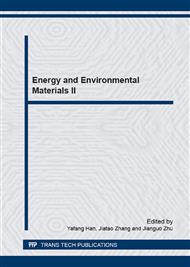p.371
p.376
p.384
p.389
p.392
p.398
p.404
p.411
p.418
Preparation and Electrical Conductivity of Polythiophene/Microcrystal Muscovite Layered Composites
Abstract:
Polythiophene(PTP)/microcrystal muscovite conductive composites were prepared by the method of intercalating polymerization via Fe3+-H2O2 catalytic oxidation system in water. The morphology, structures, electrical conductivity and thermal stability of composites have been studied preliminary. The influence of the different synthesis conditions (temperature, monomer ratio, reaction time) on the conductivity of composite materials was explored. The results of the FTIR and XRD confirmed that thiophene (TP) inserted into the layers of microcrystal muscovite to polymerize and formed intercalation compounds. TG analysis indicated the improved thermostability of composite materials. The PTP/microcrystal muscovite composite made from 2g/ml solution of microcrystal muscovite/TP with reacting for 12h and 15°C showed the highest conductivity 3.56 ×10-5s/cm-1.
Info:
Periodical:
Pages:
392-397
Citation:
Online since:
March 2015
Authors:
Price:
Сopyright:
© 2015 Trans Tech Publications Ltd. All Rights Reserved
Share:
Citation:


